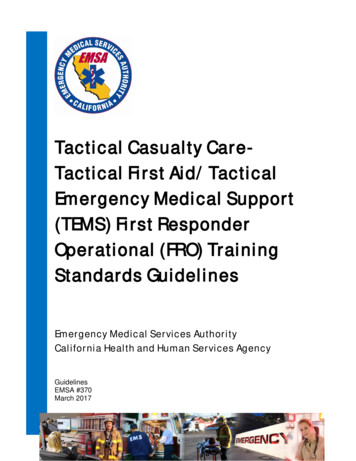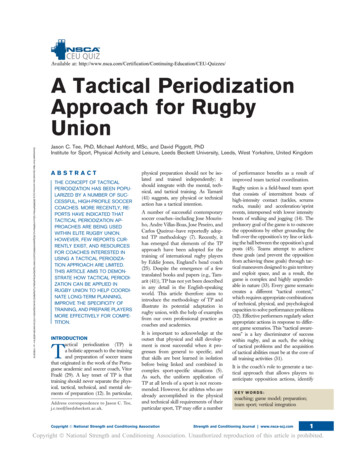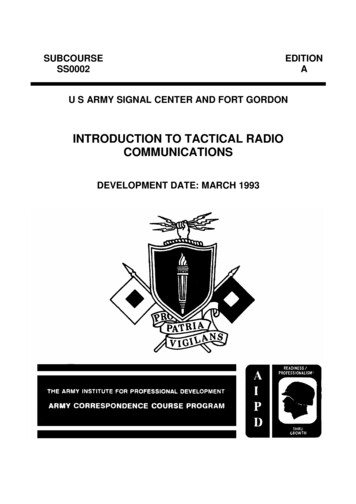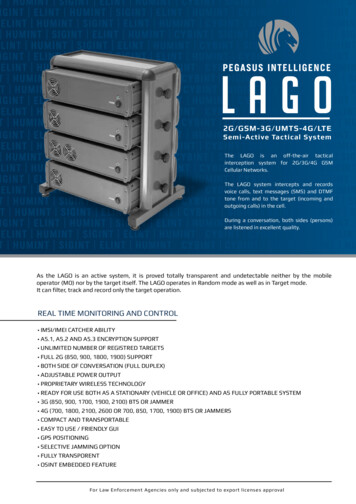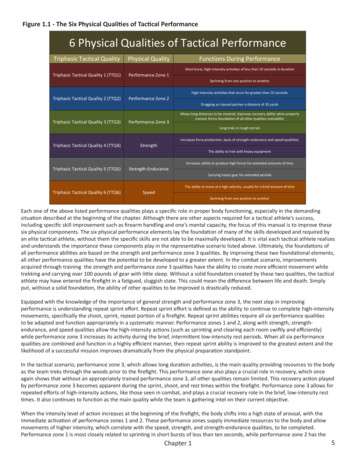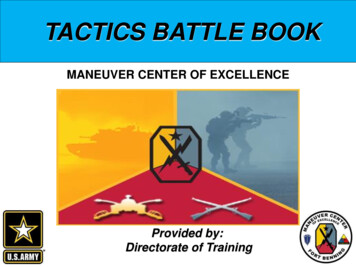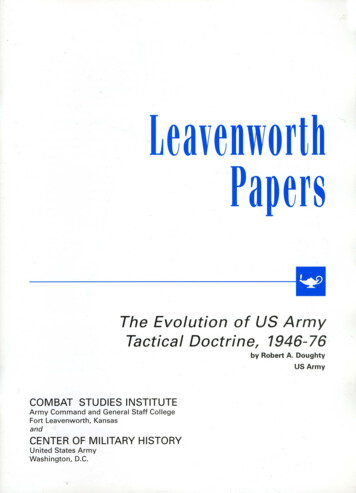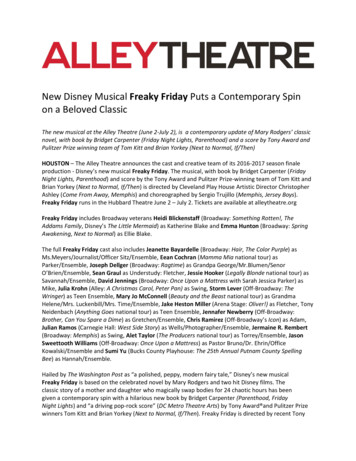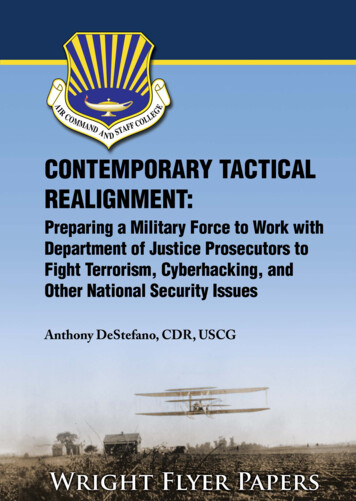
Transcription
CONTEMPORARY TACTICALREALIGNMENT:Preparing a Military Force to Work withDepartment of Justice Prosecutors toFight Terrorism, Cyberhacking, andOther National Security IssuesAnthony DeStefano, CDR, USCG
Air Command and Staff CollegeEvan L. Pettus, Brigadier General, CommandantJames Forsyth, PhD, Dean of Resident ProgramsPaul Springer, PhD, Director of ResearchJohn Terino, PhD, Essay AdvisorPlease send inquiries or comments toEditorThe Wright Flyer PapersDepartment of Research and Publications (ACSC/DER)Air Command and Staff College225 Chennault Circle, Bldg. 1402Maxwell AFB AL 36112-6426Tel: (334) 953-3558Fax: (334) 953-2269E-mail: acsc.der.researchorgmailbox@us.af.mil
AIR UNIVERSITYAIR COMMAND AND STAFF COLLEGEContemporary Tactical Realignment:Preparing a Military Force to Work with Department ofJustice Prosecutors to Fight Terrorism, Cyberhacking, andOther National Security IssuesANTHONY DESTEFANO, CDR, USCGWright Flyer Paper No. 85Air University PressMuir S. Fairchild Research Information CenterMaxwell Air Force Base, Alabama
Commander, Air Command and StaffCollegesBrig Gen Evan L. PettusAccepted by University Press March 2021 and Published September 2021.Director, Air University PressDr. Mehmed AliProject EditorDr. Achala Gunasekara-RockwellIllustratorDaniel ArmstrongPrint SpecialistCheryl FerrellDisclaimerAir University Press600 Chennault Circle, Building 1405Maxwell AFB, AL ter: https://twitter.com/aupressAir University PressOpinions, conclusions, and recommendations expressed or impliedwithin are soley those of the author and do not necessarily represent the views of the Department of Defense, the Department ofthe Air Force, the Education and Training Command, the AirUniversity, or any other government agency. Cleared for publicrelease: distribution unlimited.This Wright Flyer paper and others in the series are availbaleelectronically at the AU Press website: /
ContentsList of Illustrations vForeword viAcknowledgments viiAbstract viiiIntroduction 1Overview of the Paper 1Nature of the Problem 1Purpose of the Paper 2Research Question 3Limitations and Assumptions 3Definition of Terms 3Anticipated Significance of this Paper 4Research Methodology 4Literature Review 5US Department of Justice 5Structure, General Authorities 5Main Justice and US Attorney Offices 6Authorities Specific to National Security 8LE Task Forces 10DOJ Principles of Prosecution and Case Intake 10DOJ Prosecutors—Roles, Training, and Culture 11US Military Guidance on Working with the DOJ 12Joint Doctrine and DOD Instructions 12Posse Comitatus Act Restrictions and Assistance Authoritiesof Title 10 Forces 12USCG Regulations 15iii
Real- Life Examples of Military–DOJ Involvement 16Cybersecurity 16Terrorism 17Counterpiracy Mission 17Counterdrug Operations and Joint Interagency Task Force–South 20Practical Insights from USCG and DOJ Cooperation Analysis, Conclusions, and Recommendations 2225Analysis 25Conclusions 33Recommendations 34Meeting the Future 35Abbreviations 46Bibliography 47iv
List of IllustrationsFigure1. DOJ organization chart62. Map of US Attorney Offices73. Typical USAO organization84. “We caught them, now what?” A LEDET memberleads a “take- down” of a pirate ship” with aVBSS member185. “End- to- End” loop—Military/Law Enforcement/DOJ synergy216. Military/DOJ integration32v
ForewordIt is my great pleasure to present another issue of The Wright Flyer Papers. Through this series, Air Command and Staff College presents a sampling of exemplary research produced by our resident and distance-learningstudents. This series has long showcased the kind of visionary thinking thatdrove the aspirations and activities of the earliest aviation pioneers. Thisyear’s selection of essays admirably extends that tradition. As the series titleindicates, these papers aim to present cutting-edge, actionable knowledge—research that addresses some of the most complex security and defensechallenges facing us today.Recently, The Wright Flyer Papers transitioned to an exclusively electronicpublication format. It is our hope that our migration from print editions to anelectronic-only format will foster even greater intellectual debate among Airmen and fellow members of the profession of arms as the series reaches agrowing global audience. By publishing these papers via the Air UniversityPress website, ACSC hopes not only to reach more readers, but also to support Air Force–wide efforts to conserve resources. In this spirit, we invite youto peruse past and current issues of The Wright Flyer Papers at yers/.Thank you for supporting The Wright Flyer Papers and our efforts to disseminate outstanding ACSC student research for the benefit of our Air Forceand war fighters everywhere. We trust that what follows will stimulate thinking, invite debate, and further encourage today’s air, space, and cyber warfighters in their continuing search for innovative and improved ways to defend our nation and way of life.EVAN L. PETTUSBrigadier General, USAFCommandantvi
AcknowledgmentsI would like to acknowledge and thank Dr. Steven Shirley and Dr. AndrewNesiobedzki of the Air Command and Staff College for their mentorship andinstruction. Also, I would like to thank Mr. Joseph Poux, Esq., US Department of Justice, Mr. Scott Herman, Esq., USCG, Commander BenjaminGullo, Esq., USCG, and Commander (select) David Ratner, USCGvii
AbstractNational security strategies increasingly contemplate US military operations resulting in the criminal prosecution of terrorists, cyber hackers, transnational organized criminals, and other bad actors who seek harm to theUnited States, its citizens, and international norms. A successful merger between military and law enforcement requires the military to have a flexible,informed working relationship with the Department of Justice (DOJ), the soleagency with authority to prosecute such crimes. Joint publications and otherofficial resources have called for close collaboration between the military andthe DOJ but without meaningful, practical guidance. Operational commanders, preoccupied with warfighting and dramatic upheavals, tend to be wary ofinvolvement with civilian affairs and the Posse Comitatus Act’s complexities.Typically, the military is less comfortable with collaborating with law enforcement agencies, including the DOJ. Consequently, they can be unprepared torecognize mutual objectives, to competently gather evidence, or to preservehigh-value prosecutions.This article introduces military commanders to DOJ capabilities and thepotential for military-DOJ collaboration. It proposes a five-part frameworkfor working with federal prosecutors. First, military and DOJ authoritiesshould agree upon the types of wrongdoing which warrant military authorities sending cases to DOJ for prosecution. Second, they should identify theoperational event which triggers referral to DOJ. Third, they should determine the level of military command, which authorizes the referral. Fourth,they should identify supporting and supported roles during both operationaland investigative phases. Fifth, they should establish joint training and information-exchange programs to provide end-to-end feedback. This article suggests a practical framework that aspires to facilitate synergy between militaryand DOJ apparatuses.viii
IntroductionOverview of the PaperToday’s national security challenges often lend themselves to the “whole ofgovernment,” using all instruments of power, including law enforcement(LE).1 Military operations increasingly involve scenarios that could involvethe prosecution of offenders, including terrorism, transnational organizedcrime, and cyber incursions. Critical to success in this arena is a military partnership with the Department of Justice (DOJ), the sole US agency able tobring charges in US federal court and the lead agency for cybersecurityresponse, counterterrorism operations, and domestic response to weapons ofmass destruction (WMD). The Department of Defense’s (DOD) involvementmust be applied consistently with the principles of Posse Comitatus Act(PCA), which generally restricts the DOD’s ability to directly enforce US lawsin US territory, and its authorized assistance authorities recognized in Chapter 15 of Title 10 of U.S. Code.This paper introduces the DOJ’s mission and organization and reviewspresidential directives and joint doctrines where mission success necessitatesArmed Forces–DOJ cooperation. In search of examples to bridge the gapbetween official policies and practical applications, the paper explores contemporary problems, including cyber and terrorism cases, naval interdictionof piracy off the Horn of Africa, coordinating counterdrug operations by theJoint Interagency Task Force–South (JIATF–S), and the US Coast Guard’s(USCG) well- established working relationship with the DOJ. Unique amongthe Armed Forces, PCA restrictions do not apply to the USCG, which hasbroad LE authorities per Title 14 of U.S. Code.2 The USCG’s practices, therefore, yield valuable practical insights on military–DOJ collaboration, particularly how to identify the types of wrongdoing warranting prosecution by theDOJ and when and how specific cases should be sent to the DOJ.Nature of the ProblemNotwithstanding the importance of Armed Forces–DOJ cooperation,military commanders typically accrue little experience or training regarding interaction with the DOJ. Thus, commanders can find themselves thrustinto unfamiliar situations where they must apprehend domestic or international wrongdoers for prosecution by US or foreign authorities. This lack ofpreparation tends to frustrate the joint doctrine concept of “Unity of Effort,”where different entities are expected to form mutual objectives and utilize1
each other’s capabilities. In contradistinction, the Air Command and StaffCollege curriculum for conventional challenges has training modules foreach branch of the Armed Forces, the Departments of State and HomelandSecurity (hereinafter DOS and DHS, respectively), as well as other agencies—but not the DOJ. The training- gap is significant since the DOJ is oneof the four main agencies of the national security apparatus (along with theDOD, DOS, and DHS).At strategic levels, lack of understanding risks failing to recognize or formulate combined military–LE instruments of power. On operational levels,military commanders could fail to identify criminal actors (even terrorists)wanted by LE officials. One study states that 90 percent of pirates interdicted by military forces at sea were summarily released, underminingexpensive international prosecution efforts.3 Military commanders mayalso fail to gather critical evidence. A USCG officer involved in counterpiracy operations recounted how the US Navy, after interdicting pirates, wasunprepared to gather evidence, handle detainees, or arrange for disposition.4 Conversely, military operations have demonstrated successful mergers of the military and LE in capturing or gathering evidence about internationally wanted terrorists, combating the scourge of Somali piracy, andstemming the flow of illegal drugs.5The need for combined military/LE operations may expand with increasingly complex national security strategies. DOD cyberoperations contemplate cooperation with LE agencies in election security and providing information about cyberattackers being transferred to LE agencies for investigationand prosecution.6 Reflecting recent developments, in July 2020, US CyberCommand publicly acknowledged its aid to the DOJ, which brought criminaland civil actions against North Korean cyberhackers who stole 250 millionin cryptocurrency.7 Military and LE synergies may also emerge in unexpectedscenarios such as Chinese fishing vessels encroaching upon other nations’ exclusive economic zones to normalize adverse maritime claims; a responsecould involve LE action against illegal fishing.8Purpose of the PaperThis paper aims to identify a general framework for military commandersto work with DOJ prosecutors, including identifying cases to send to the latter. This framework emphasizes flexibility, given the breadth of missions andstrictures of federal law.2
Research QuestionJoint doctrine states that “long- term strategic competition requires theseamless integration of multiple elements of national power—diplomacy, information, military, economic, financial, intelligence, and law enforcement.”9Integrating military and LE elements may become increasingly importantwith emerging threats in terrorism, cyberspace, espionage, and other areas.The research question is thus: how should military commanders prepare theirunits to work with DOJ prosecutors when operations may involve apprehension and prosecution of offenders?Limitations and AssumptionsCriminal, international, and national security law is complex. Several topics are beyond this paper’s scope. This paper is not intended as a legal reference, particularly concerning the restrictions of the PCA and related Title 10provisions. Any examples of combined military and LE operations are illustrative and not intended as a complete account of the referenced situation.Also, this paper cannot establish definite rules guiding when criminal prosecution should be applied to national security problems. Instead, it will discusshow military and DOJ leaders should work together to identify mutual objectives and accomplish them. It also steers clear of debates about LE and military solutions to national security problems. For example,, this paper does notaddress the strenuous debate between those supporting trying terrorists incourt and those proposing drone strikes to eliminate such individuals. Similarly, it does not discuss the debate between trying terrorists before militarytribunals rather than federal court.Definition of TermsChain of custody: The movement and location of real evidence and the history of persons who had it in their custody from the time it is obtained to thetime it is presented in court.10Evidence: Something that tends to prove or disprove the existence of an allegedfact; evidence includes eyewitness accounts, documents, and tangible objects.11Judge advocate (JAG): A military attorney who is a commissioned officerand provides legal advice to his or her assigned branch of the Armed Forces.12Military criminal investigative organization (MCIO): Organizations chargedwith conducting complete and accurate criminal investigations involving military personnel and operations; each military department has its own MCIO,3
e.g., Naval Criminal Investigative Service (NCIS), Air Force Office of SpecialInvestigations (AFOSI), and Coast Guard Investigative Services (CGIS).13Probable cause: A brief by a reasonable and prudent person, in the totalityof the circumstances, that someone has committed a crime or that a placecontains certain evidence; generally, the threshold for seizing property orarresting persons.14Proof beyond a reasonable doubt: The standard used to determine whethera criminal defendant is guilty in court; usually proof of a “convincing character that a reasonable person would not hesitate to rely and act upon in themost important of his or her own affairs.”15Prosecute: To institute and pursue criminal action against a person.16Referral: The act or an instance of sending or directing an offense to theDOJ for further investigation and possible criminal proceedings.17Special agent: An investigator for a federal LE agency, including an MCIO.18Anticipated Significance of this PaperThis paper aspires to promote military commanders’ understanding of theDOJ’s authorities and capabilities and to present basic ideas of how to integrate military operations with DOJ prosecutors. This paper could be informative in how combatant commanders and subordinate joint force commandersintegrate military—LE operations and the needs of DOJ prosecutors into theJoint Operation Planning Processes. The Armed Force’s war colleges and JAGtraining centers could develop training modules using this paper and subsequent research. Armed Forces JAG programs could develop training programs for currently serving JAGs, especially those slated for Special AssistantUS Attorney or “operational law” billets. This paper’s recommended framework could assist US Joint Operations Command’s desired research into howDOJ can assist police operations in Afghanistan.19Research MethodologyThis paper uses a problem/solution approach (discovering and revisingknowledge about an issue). For practical insights, it will explore case studies,namely the US Navy’s counterpiracy mission, the success of JIATF–S, and theUSCG’s relations with the DOJ. The lattermost should be particularly valuablegiven the USCG is the only Armed Force that is also a federal LE agency andthus is unencumbered by PCA and other federal laws and regulations restricting the military to engage in LE missions.4
Literature ReviewUS Department of JusticeThe Justice Manual consolidates the DOJ’s organization, missions, andnonsensitive policies in one online source.20 This paper reflects two interviewswith DOJ prosecutors and one interview with a USCG officer to gather practical insights into how DOJ and military personnel can best cooperate. The firstinterview was with Joseph Poux, a member of the Senior Executive Service forthe DOJ in Washington, DC, with more than 18 years of experience developing cases with the USCG. Whereas some senior DOJ officials would berestricted from divulging sensitive national security issues, Poux could berelatively open given his focus on environmental crimes that involve businessentities and processes aired in court. The second was with CDR Ben Gullo, aformer Assistant US Attorney with the Northern District of Ohio. The thirdwas Scott Herman, a GS-15 and retired commander, with experience as a Special Assistant US Attorney and as a USCG officer who has worked extensivelywith DOJ.Structure, General AuthoritiesThe DOJ is the sole agency with the authority to represent the United Statesin court and to bring charges or legal actions on behalf of the United States.21Its mission statement is: “To enforce the law and defend the interests of theUnited States according to the law; to ensure public safety against threats foreign and domestic; to provide federal leadership in preventing and controlling crime; to seek just punishment for those guilty of unlawful behavior; andto ensure fair and impartial administration of justice for all Americans.”22A military officer should be familiar with the DOJ components relatingto national security. These are, especially, the Criminal Division (supervisesenforcement of all federal criminal laws),23 the Drug Enforcement Agency,24the Federal Bureau of Investigation (FBI; lead operational agency for investigating and responding to terrorism, hostage incidents, cyberattacks, anddomestic WMD),25 and the National Security Division (counterterrorismand counterespionage).26The attorney general is the head of the DOJ and oversees 38 componentsand 93 US Attorney Offices. The DOJ’s organizational chart is in figure 1.5
(Source: “Organizational Chart,” US Department of Justice, accessed 21 September 2019, https://www.justice.gov/agencies/chart.)Figure 1. DOJ organization chartMain Justice and US Attorney OfficesThe litigation components overseen by the US attorney general (e.g., theCriminal Division) are often referred to as “Main Justice” or the “JusticeDepartment.”27 These have the authority to bring charges anywhere in theUnited States.28 Each of the 93 US Attorney’s Office (USAO), however, areconsidered the principal litigation units; they have the authority to bringcharges in their districts.29 A map of the USAOs is provided in figure 2.Poux and Gullo emphasized military officers need to understand thatMain Justice and the USAO operate concurrently but separately. EachUSAO “acts with significant autonomy,” said Gullo.A US Attorney, appointed by the president with the advice and consent ofthe Senate, oversees each USAO.30 While the US attorney general is thenominal supervisor for each US Attorney, only the president may remove aUS Attorney.31 US Attorneys are considered the chief federal LE officer intheir respective districts, with plenary authority to investigate and bring ordecline prosecutions.32 This framework gives each USAO great independence, reflective of the need for justice to be free of political constraints.6
Both Main Justice and the USAOs may bring cases independently andmaintain divergent policies. In rare circumstances, one may bring chargesagainst a defendant when another refuses.(Source: “Find Your US Attorney,” US Department of Justice, accessed 21 September 2019, ttorney.)Figure 2. Map of US Attorney OfficesUSAOs vary in size ranging from 300 or more Assistant US Attorneys(AUSA) to 30–40 AUSAs in more remote ones.33 The US Attorney’s deputy isthe “First Assistant US Attorney,” a career public servant.34 Each USAO has aCriminal and Civil Division overseen by a “chief.”35 Each division has“bureaus,” which vary from USAO to USAO. The AUSAs will be assigned toone of the bureaus. An AUSA may have an agency or agencies as a “portfolio.”For consistency, cases referred by that agency will come to him or her. Thereis no standard USAO organization chart. The organization chart in figure 3was adapted from interviews.7
Figure 3. Typical USAO organization36Some USAOs are considered more influential than others, depending ontheir physical venue. The Southern District of New York (S.D.N.Y.), located inNew York City, is regarded as one of the most potent entities in government,given its LE powers over Wall Street and international trade.37 After the September 11th attacks, the S.D.N.Y. invigorated its national security and counterterrorism strategies, becoming a national leader.38 The S.D.N.Y. often drivesnational practices in high- profile areas such as terrorism, white- collar, andmafia cases.39Authorities Specific to National SecurityDOJ prosecutors are critical players in national security because they canprosecute violations of laws where Congress has created a framework to combat terrorism, foreign espionage, and other issues.40 These prosecutors alonecan effectuate these laws in federal court, subpoena records, and effectuatesearch and arrest warrants.Such laws usually apply to conduct outside as well as inside US territory.41The DOJ can either indict or charge persons located overseas and seek extradition.42 Alternatively, and more commonly, LE can arrest and bring persons8
to the United States, where they are generally charged in the district court towhich they are first brought.43 The breadth of jurisdiction led former USAttorney Preet Bharara to deadpan, “Are you familiar with Earth?” whenasked as to the limits of the DOJ’s reach.44 As one DOJ prosecutor told theNew Yorker, “I think military investigators see us as finishers. They may havea lot of evidence on somebody. We’ve got the machinery, and the credibility,to charge and try that person.”45 DOJ prosecutors are the only persons authorized to appear in court, subpoena records, and effectuate federal search andarrest warrants. Examples of DOJ involvement in national security include:Terrorism: Presidential directives designate the DOJ as the lead agency forapprehending and trying foreign and domestic terrorists wherever located,including cyber and WMD events.46 The DOJ has the power to prosecutedomestic terrorists, any US citizen engaged in or assisting terrorists overseas,foreign terrorists who attack US citizens, and those engaged in terrorist actstranscending national boundaries.47 General statutes also enable the DOJ toprosecute those who commit other acts related to terrorism such as assault onfederal officials.48 The 2018 National Strategy for Counterterrorism recognizesusing the DOJ stating, “[DOD counterterrorism] capability, in certain circumstances, also permits detention of terrorists for transfer to the UnitedStates for criminal prosecution.”49Insurrection and civil disturbance: The US attorney general is tasked withrestoring law and order in the aftermath of insurrection or civil disturbancein the United States.50 The president would deploy the Armed Forces to support the DOJ in restoring public order.Cybersecurity: The DOJ, acting through the FBI and Cyber- Digital TaskForces, is the lead federal agency for responding to cybersecurity threats.51Joint doctrine recognizes cyberoperations by the Armed Forces could support these efforts.52Transnational organized crime: The DOJ would ultimately prosecute transnational organized crime threatening the United States and its citizens.53 Suchcrimes include drug trafficking, cyberattacks, and intellectual property theft.Espionage and foreign agents: The DOJ would prosecute treason, espionage,unlawful activities involving classified material, unauthorized activities by foreign entities, and violations of export laws involving national security matters.54Sanctions and arms embargos: The DOJ uses criminal and civil forfeitureproceedings to hold persons and companies accountable for circumventingUS sanctions against foreign countries. For example, the DOJ brought civilforfeiture proceedings to seize a North Korean vessel that bypassed US sanctions using unwitting US banks to finance ship maintenance.559
LE Task ForcesThe DOJ develops and leads LE task forces, which include federal, state,and local LE agencies, to coordinate efforts against certain categories ofcrimes.56 LE task forces operate at the national level (at the direction of thedeputy attorney general) and at the regional level (led by USAOs).57 LE taskforces include the Organized Crime Enforcement Task Force Program,58 JointTerrorism Task Forces (JTTF),59 Intellectual Property Task Forces,60 and theCyber- Digital Task Force.61 MCIOs typically embed special agents in relevantLE task forces to coordinate efforts.DOJ Principles of Prosecution and Case IntakeThe Principles of Federal Prosecution guides DOJ prosecutors in bringing ordeclining charges.62 Charging a person or organization has profound impactson targets and victims regardless of whether a conviction prevails.63 The DOJrecognizes that appropriate charging decisions ensure “the fair and effectiveexercise of prosecutorial resources” and promote “confidence on the part ofthe public and individual defendants” that charges are brought “rationally andobjectively on the merits of each case.”64 Every military officer should read thePrinciples of Federal Prosecution. Demonstrating its influence, the Manual forCourts- Martial adapts it to guide military commanders considering court- martial proceedings.The Principles of Federal Prosecution instructs DOJ prosecutors to commenceor recommend federal prosecution if he or she “believes that the person’s conduct constitutes a federal offense, and the admissible evidence will probably besufficient to obtain or sustain a conviction.”65 However, it instructs DOJ not tocommence such action if “(1) the prosecution would serve no substantial federal interest; (2) the person is subject to effective prosecution in another jurisdiction, or (3) there exists an adequate non- criminal alternative to prosecution.”66Whether a prosecution serves a “substantial federal interest” is guided by ninecriteria including (1) federal LE priorities, (2) nature and seriousness of theoffense, (3) deterrent effect, (4) culpability, (5) criminal history, (6) person’swillingness to cooperate, (7) personal circumstances, (8) interest of victims, and(9) probable sentence/consequences upon conviction.67The need to preserve resources and public confidence means DOJ prosecutors carefully analyze when to bring charges. As Gullo relates, DOJ prosecutors need to be personally convinced the target committed the offense and theevidence is sufficient to sustain a conviction.6810
DOJ Prosecutors—Roles, Training, and CultureMilitary officers should be introduced to DOJ prosecutors’ prestige, background, and independence. DOJ prosecutors are both criminal investigatorsand trial attorneys. They frequently coordinate efforts of multiple federalagencies to investigate alleged offenses.69 Federal investigators report to theirown agencies; however, in practice, DOJ prosecutors take control once theydecide to pursue a case.70DOJ prosecutors take pride in their independence and commitment to justice. One explained to the New Yorker, “Your job as the U.S. Attorney is to dothe right thing. You go after bad guys. You’re doing something for societyevery day.”71 They see criminal prosecution as a way to solve societal problems. As Preet Bharara put it, “Prosecutors alone are not going to solve theproblem. But . . . we can give these issues a sense of urgency. A lot of peoplewake up to the possibility of better government when you start putting peopleinto prison.”72 Prosecutors aim to compel compliance in three principal ways:lawfully incapacitating criminals via imprisonment, deterring others throughthe threat of imprisonment, and restructuring corporations and businessorganizations through remedial tools (criminal and/or civil).Becoming a DOJ prosecutor is highly selective. A single DOJ trial attorney73 or AUSA position has upward of 600 applicants.74 Most applicationsrequire a minimum of five years of litigation experience. Selectees are typically high- performers from elite law schools or have special qualificationssuch as extensive trial experience or outstanding military service.75 Manynational leaders start their careers in the DOJ (e.g., Senator Mitch McConnell(R–KY),76 former director of the FBI James Comey, former mayor of NewYork City Rudolf Giuliani, and former direc
iii Contents List of Illustrations v Foreword vi Acknowledgments vii Abstract viii Introduction 1 Overview of the Paper 1 Nature of the Problem 1 Purpose of the Paper 2 Research Question 3 Limitations and Assumptions 3 Definition of Terms 3 Anticipated Significance of this Paper 4 Research Methodology 4 Literature

